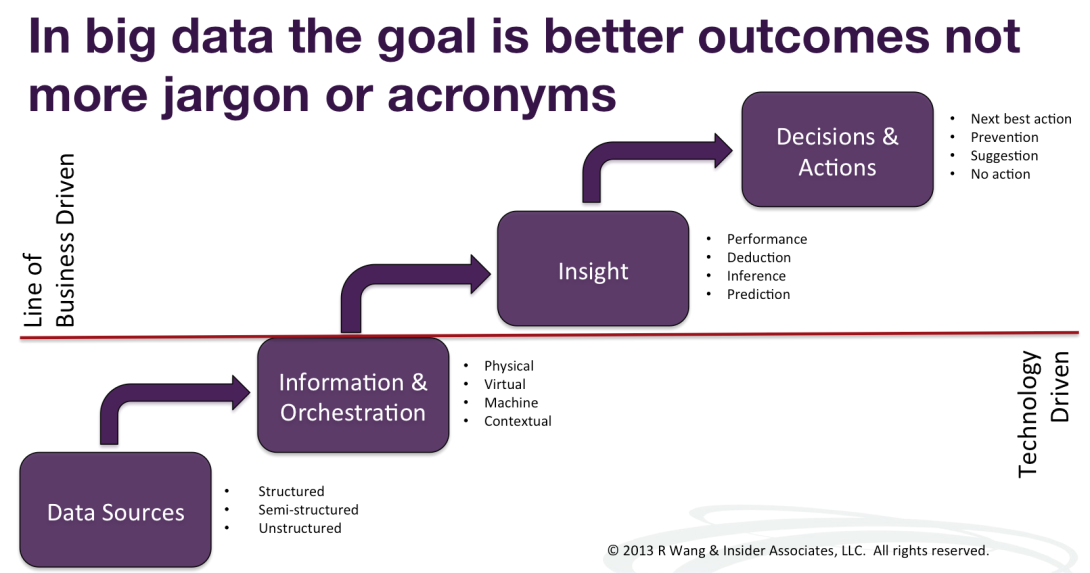
Tuesday's Tip: Focus On The Business Outcomes, Not Technology With Big Data
The Why Behind Big Data Starts By Asking What's The Business Outcome
So organizations have lots of data. New techniques have emerged to correlate big data. Enamored by the potential of big data, leaders are now reinvesting in technologies to find hidden nuggets of insights with the business goals of:
- Mitigating regulatory risks
- Identifying operational efficiencies
- Improving revenue growth
- Creating market differentiation
- Expanding the brand presence
These big data use cases often follow the business hierarchy of needs, which are based on concepts pioneered by Maslow (see Figure 1). More importantly, a key question in big data has been to ask the right question.
Figure 1. The Business Hierarchy of Needs Drives Many Big Data Use Cases
An Information Flow Approach Moves The Discussion From Data To Decisions
Unfortunately, the problem is most organizations start by talking about outcomes and then get mired in the technologies to achieve these outcomes. Big data technologies include advanced business analytics, application of existing technologies such as data warehousing and business intelligence. In many cases, application of decision automation, semantic technology and collaborative tools are also needed. Yet, from Data to Decisions requires the integration of quite a few disciplines.
Data to decisions is about taking data sources, transforming them into useful information, gathering key insights, and then making the right decisions (see Figure 2). Data sources, information, and orchestration belong in the realm of IT and hopefully will be delivered via the cloud. Insight, decisions, and actions are line of business driven areas which deliver the most value add:
- Data sources. Expect a mix of structured, semi-structured, and lots of unstructured.
- Information and orchestration. The mix of information types include physical, virtual, machine, and contextual.
- Insight. Information translated to insight considers performance, deduction, inference, and prediction.
- Decisions and actions. The outcomes are driven from next best action, prevention, suggestion, and even no action.
Figure 2. The Flow From Data To Decisions
The Bottom Line: Expect A Focus On Outcomes Not Technology As Big Data Awareness Matures
Early adopters and fast followers will shift quickly to business outcomes focused with their big data projects. Why? Budgets for big data are coming from the business side who expect an outcomes based approach. Organizations will adopt a use case approach to tackle the big questions and along the way unearth new questions to answer. Meanwhile, expect the IT side of the big data equation to emerge as a service or platform that makes the technology aspects consumable. Will you and your organization be ready to act on this insight?
Your POV
What business problem will require you to start with Big Data? What are the key outcomes? Where do you expect to move the needle? Add your comments to the blog or send us a comment at R (at) SoftwareInsider (dot) org or R (at) ConstellationRG (dot) com
Resources
- Tuesday’s Tip: Why Context Matters – Forget Real-Time, Achieve Right-Time
- Monday’s Musings: Beyond The Three V’s of Big Data – Viscosity and Virality
- Monday’s Musings: The Three V’s of Big Data
- Research Report: Rethink Your Next Generation Business Intelligence Strategy
- Monday’s Musings: Balancing The Six S’s In Consumerization Of IT
- Monday’s Musings: A Working Vendor Landscape For Social Business
- Research Report: The Upcoming Battle For The Largest Share Of The Technology Budget Part 1
- Research Report: How The Five Pillars Of Consumer Tech Influence Enterprise Innovation
- Best Practices: Five Simple Rules For Social Business
Reprints
Reprints can be purchased through Constellation Research, Inc. To request official reprints in PDF format, please contact Sales .
Disclosure
Although we work closely with many mega software vendors, we want you to trust us. For the full disclosure policy, stay tuned for the full client list on the Constellation Research website.
* Not responsible for any factual errors or omissions. However, happy to correct any errors upon email receipt.
Copyright © 2001 -2013 R Wang and Insider Associates, LLC All rights reserved.
Contact the Sales team to purchase this report on a a la carte basis or join the Constellation Customer Experience!
 R "Ray" Wang
R "Ray" Wang R "Ray" Wang
R "Ray" Wang

